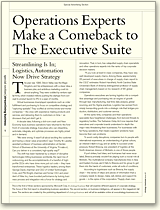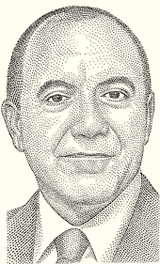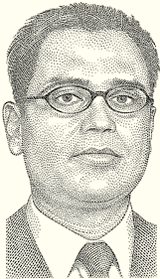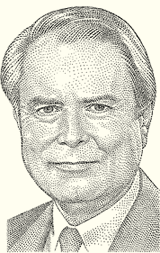Operations Experts Make a Comeback to The Executive Suite
This section is from the Summer 2006 issue of strategy+business
Operations Experts Make a Comeback to The Executive Suite
Streamlining Is In; Logistics, Automation Now Drive Strategy
The year was 1996. Silicon Valley was the Magic Kingdom, and hip entrepreneurs with a clever idea, a business plan, and ambitious marketing could do almost anything. They were coddled by venture capital firms, which invested millions pushing the startups from concept to product launch to IPO in a span of months.
Virtual businesses downplayed operations such as order fulfillment and purchasing to focus on competitive strategy and “capturing eyeballs.” They scoffed at old-line bricks-and-mortar companies — the ones with experience making products and services, and delivering them to customers on time — as dinosaurs that just didn’t get it.
A decade later, following a dot-com crash and New Economy bust, business operations have returned to the forefront of corporate strategy. Executives who can streamline, automate, integrate, and optimize processes are highly prized and in demand.
“We were wrong. It wasn’t all about exciting the customer and having a clever value proposition,” says Timothy M. Laseter, assistant professor of business administration at Darden School of Business at the University of Virginia. “It is about, Can you deliver in a consistent, high-quality way?”
The shift has been hastened by a stream of disruptive technologies hitting businesses worldwide, the rapid rise of outsourcing, and the accomplishments of a handful of high-profile CEOs who have done more just cut costs — they have transformed enterprises. These logistics leaders, among them George David, chairman and CEO of United Technologies Corp., and Phil Knight, chairman and former CEO and president of Nike Inc., have boosted performance by turning business process and integration into a force for strategy and innovation. That, in turn, has catapulted supply chain specialists and other operations experts into the ranks of top corporate decision makers.
“If you look at best-in-class companies, they have very well-developed supply chains. Among these, approximately 25 percent of executives in charge of supply chain report to the CEO,” estimates Robert Handfield, North Carolina State University’s Bank of America distinguished professor of supply chain management, based on his research of 80 global companies.
Operations executives are turning logistics into a competitive advantage and purchasing into an engine of growth through lean manufacturing, real-time data analysis, global sourcing, and Six Sigma practices. Logistics has evolved from simply transporting goods into a strategic role that bridges production, distribution, and customer service.
At the same time, companies and their operations specialists face heightened challenges, from terrorist threats to regulatory hurdles. The Sarbanes-Oxley Act now requires that executives and corporate boards understand in depth the major risks threatening their businesses. For businesses with far-flung operations, that means suppliers’ problems have become their own problems.
To avoid costly disruptions, companies turn to people with international experience, an understanding of global culture, an interest in technology, and an ability to succeed under pressure. Robert Brescia, vice president of logistics at the North American division of Michelin, is one of those people.
If port strikes, fuel hikes, and hurricanes had never escalated, Brescia probably wouldn’t be playing such a crucial role at Michelin. The multinational company manufactures tires in Asia and Eastern Europe, and it falls to Brescia and his group to get them into the hands of customers, under all sorts of conditions.
|
Brescia joined Michelin in March 2001, and helped the company keep tires moving after the September 11 terrorist attacks, the West Coast port strikes in 2002, and Hurricane Katrina last year. Before the hurricane landed, Brescia and his team got busy collecting detailed data. They queried suppliers, related companies, and scores of other sources to pinpoint product arrival schedules at ports and customer delivery dates, and to maintain real-time weather forecasts. That information was distilled into a map and white-board diagrams analyzing scenarios that would affect Michelin’s supply chains.
“When you’re faced with a supply chain challenge or problem, it helps greatly to visualize it,” says Brescia.
Tires due to land in New Orleans and other threatened areas were rerouted and reached customers on time.
Brescia’s role includes participating in strategic corporate decisions, including one to outsource the company’s North American distribution network. He meets with sales and marketing executives to help them factor manufacturing and shipping costs from different locations into overall product prices.
Brescia says his biggest challenges are reducing inventory and operational costs while improving supply stability and customer satisfaction.
“The pressure is to hold no inventory,” says North Carolina State University’s Handfield. “But when there are blips in demand, companies have very little product and not enough production capacity. It’s a difficult balance to achieve.” Handfield praises Michelin’s demand-planning expertise, based on working with its biggest customers to forecast market changes.
“Supply chain management can be very short-term focused: ‘Forget about 10 years in the future, I need it now,’” says Mahender Singh, the project manager for Supply Chain 2020, a research initiative launched by the Center for Transportation and Logistics at the Massachusetts Institute of Technology. The effort is being conducted in collaboration with the Zaragoza International Logistics Program, an alliance among the University of Zaragoza in Spain and local Spanish government and industry partners.
|
In the project’s first phase, researchers sought to identify excellent supply chains across a range of industries. They see supply chains as unique to each corporation, like a fingerprint, and emphasize that what works for one business won’t necessarily succeed at another.
Singh says superior supply chains share certain characteristics, including:
-
Their operating models create a competitive advantage for the business.
-
They emphasize high-performance execution that is defined by metrics.
-
They support and enhance the overall strategy of the business.
The pressure to streamline operations has forced companies to turn to supply chain wizards such as Eldon Griggs, at BlackHawk Products Group in Norfolk, Va. He was hired two years ago to fill a newly created position — vice president of global sourcing and purchasing — and to run a new four-person unit that the company sees as key to its future growth.
The CEO of BlackHawk — a 200-person company that bills itself as a manufacturer of tactical products for military, law enforcement, and consumer markets — meets with Griggs at least once a week.
“Ten or 15 years ago, I don’t think there would have been a position such as mine. Medium-sized companies weren’t really thinking about it,” Griggs says of his work searching for suppliers and materials around the world to make the company’s boots, apparel, and equipment. The company created his position when it realized it had ideas for new products but no place to make them. Enter Griggs, who prior to joining BlackHawk had worked for a national distributor where he had developed an expertise in supplier discovery. He used those contacts to help launch an in-house product line, the distributor’s first. Now BlackHawk outsources most of its manufacturing.
|
Griggs views his role as a sort of bridge. “We streamline business operations by helping to reduce costs and to increase sales,” he says. His job marries traditional purchasing with strategic sourcing, which involves collaborating with researchers and product developers and finding new suppliers to make products.
Even before designs are created, Griggs or a member of his group meets with BlackHawk’s product developers to understand their goals and provide them with information on suppliers and costs.
Recently the company decided to introduce a line of “Warrior Wear” boots. Griggs found a supplier in China and from the supplier learned what kinds of materials were available. “From that conversation we could go back to the designers and say, ‘Here are our choices in terms of materials and time.’”
Still, outsourcing is no panacea, and many executives are increasingly dissatisfied with what they’re getting. Typical complaints: Deadlines are missed, quality is low, prices are higher than originally negotiated. Companies are restructuring contracts, looking for new suppliers and redefining strategies.
That has underscored the flawed strategy of many manufacturing companies that turn to outsourcing in order to fight price and performance competition, according to Kaj Grichnik, Conrad Winkler, and Peter von Hochberg of Booz Allen Hamilton in a spring 2006 article in strategy+business.
“As a last resort, companies outsource production, and thus erode their own competence in it,” the authors wrote. “Gradually, manufacturing is treated more and more as an outcast, and plant communities become disenfranchised.”
Instead, companies should address manufacturing productivity “as a long-term, organization-wide strategic imperative and not as an isolated operational or functional issue.” Rather than simply flee to outsourcing, companies need to innovate their own processes by developing a holistic strategy. To do this, they must peel back and analyze the operational data buried in four dimensions: technological distinction, network sophistication, in-plant transformation, and labor modernization. (See the table below.)
The goal: “A global, flexible supply chain network that can be reconfigured anywhere in the world as market conditions change.”
Supply Chain 2020, the MIT-based research group, has now turned its attention to the future as it tries to forecast how events might affect company operations 10 to15 years from now. It is weighing scenarios such as political upheaval that cuts manufacturing in China, the effect of aging populations, global health epidemics, and oil and water shortages.
But there are different views on what constitutes a realistic scenario. Some experts predict that advances in technology, manufacturing, and communications will increase corporate connectivity. Businesses will act like organisms — merging operations opportunistically, then parting — as circumstances require. That takes for granted deep trust among participants who share information and expertise.
Other experts forecast the opposite — that information competition will define corporate behavior in coming decades.
Singh says that either way, supply chain experts with an informed view of the future have a seat in the executive suite.
“It used to be: ‘Supply chain? Whatever. Just make it happen,’” Singh says. “Now CEOs understand the problems and their implications.”
The Four Dimensions of a Manufacturing Makeover
| “Identifies” — Level I |
“Identifies” — Level I |
“Shapes Actively” — Level III |
“Learns and Iterates” — Level IV | |
| Managing the Customer | Customers grouped into like segments (e.g., by value, profitability, need) |
Customers understand different offerings but |
Customers are actively steered to correct channels for needs (e.g., coaching clients to use Web channels, putting a price tag on higher service) |
Customers are constantly de-averaged — assignment across segments is actively managed over time |
| Delivering Value • Features • Service Levels • Experience |
Overall performance aspirations defined |
Qualifiers/differentiators Target client service experience defined |
Target service experience while guiding service behavior and channel usage Value captured from differentiation (e.g., reduced customer churn) |
Managing the mix of qualifiers and differentiators in the portfolio of services over time |
| Managing Cost | Measurement and understanding of direct costs of client service |
Total cost-to-serve (CTS) view of client service Activities segmented to |
Understanding cost drivers by activity (e.g., acting to reduce phone channel costs by identifying key cost drivers) Activity overlaps minimized across channels |
Feedback loop for continuous improvement (kaizen) Explicit use of cost drivers for continuous cost management |
| Using Service Architecture and Aligning Demand and Supply |
Articulated list of services Existence of either demand |
Scale/utilization out of “same as” efforts Demand and supply segmentations exist but are not aligned |
Creation of more “same as” while ensuring unique needs are catered to (e.g., modu- larizing service) Demand and supply aligned through a delivery infrastructure |
Explicit trade-offs on features and service levels to manage innovation gainfully Demand and supply regularly realigned in future |
|
“Base” |
“Channel Alignment” |
“Tailored Business Streams (TBS)” |
“Dynamic TBS” |
To develop a holistic manufacturing strategy, businesses must move beyond simple benchmarking exercises and assess operational data buried in four dimensions, according to Kaj Grichnik, Conrad Winkler, and Peter von Hochberg in “Manufacturing Myopia,” strategy+business, Spring 2006.
How BMW Transformed Purchasing Into a Force for Strategy and Innovation
|
“The department did not have a lot of respect. Morale was low,” says Wolf, now a professor at the Technical University of Munich.
Wolf inherited 123 employees and a department that operated as an order-taker with a short-term focus: getting the best prices for BMW’s purchases. He was determined to transform the division into a strategic center from which other departments would seek help to improve their own performance.
“Today we see strategic purchasing of indirect materials high on the agenda of many large companies, but BMW was among the first to take this challenge,” says Arjan Van Weele, a professor of purchasing and supply management at Eindhoven University of Technology in the Netherlands.
The technical procurement department buys everything BMW needs except parts for the vehicles the company makes. Purchases range from capital equipment and facility construction to computers and service contracts, for operations worldwide.
Wolf saw the group’s potential: With extensive supplier relationships, rich industry knowledge, advanced data analysis, and experts who understood vendors’ technology and processes, purchasing could influence product design and development. It could transform itself from administrative function into central information hub, sharing innovations across supply chains.
To achieve those goals, Wolf says, he needed to streamline operations and persuade three groups to see things his way: employees in purchasing, corporate colleagues outside the department, and vendors.
Wolf, who left BMW in 2004, describes the three steps in a transformation that took a year and a half:
1. Start with people, and empower them.
Wolf knew problems began with the way the department regarded itself, as an end-of-the-line function. Its in-house clients would call when they needed a product or service, but never for ideas. “Staff told me, ‘We’re not loved and we’re not integrated.’ And I said, ‘If you added value, you would be integrated.’”
Purchasing employees, most of whom had been with the manufacturer for more than 15 years, agreed to make changes.
Wolf introduced a process to identify qualifications buyers needed to add value for BMW. Working together, the department listed more than 1,000 skills and areas of expertise. Anyone who lacked the newly defined skills was enrolled in training, provided by knowledgeable colleagues or outside experts.
The department also agreed on shared values that would guide its actions. These included integrity, trust, innovation, and a commitment to getting results and creating a satisfying work environment.
2. Give colleagues proof of success.
After training was complete, Wolf set out to partner his new purchasing department with the rest of BMW. He encountered broad resistance. “You stay in the corner and be quiet. We have so many partners, we don’t want another,” Wolf recounts colleagues saying.
He won converts by showing proof of his group’s new competence. Pruning supply contracts was an early success. At the time, BMW had 107 different contracts for air conditioning service in Munich alone. Within three months, the department consolidated them into one at a cost savings of 75 percent.
Then the group analyzed all BMW purchases and found that 80 percent of them amounted to less than $5,000. In a move to let its own buyers focus on bigger decisions, the department created contract templates and certified buyers in other offices. That allowed the offices to order their own supplies, freeing the department from small, routine tasks while preserving its procurement oversight.
3. Streamline supply base, and partner with key suppliers.
Then Wolf turned to suppliers. His department was experienced in negotiating and buying, but it lacked specialists in the products and services needed by BMW. He recruited experts in such areas as heavy equipment and construction management. The cost specialists grew to a team of 40. They studied suppliers’ systems and price structures and required changes when necessary, or sought new suppliers. As the group developed a reputation outside the company, suppliers began to ask if they could borrow cost specialists to help streamline their own operations. That created partnerships between BMW and its suppliers, recalls Wolf. “We encouraged them to reduce costs. But, without charging them, we also sent these highly trained people to help them.’’
This is the first of three sections sponsored by Microsoft Corp. in strategy+business that will examine different aspects of corporate strategy. The focus of this first report is streamlining business operations. The second section, on customer service integration, appears in this magazine’s autumn issue. The sections are created by the publishing department of strategy+business.









